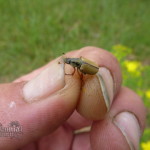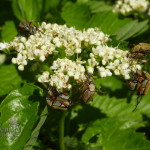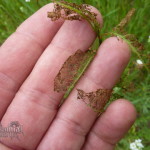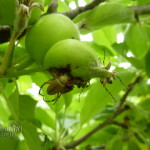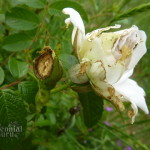It was another bad year for rose chafer (Macrodactylus subspinosus, Scarabaeidae) in northwestern Michigan.
The beetle pest is primarily a problem in the northeastern and midwestern US, particularly in areas with sandy soils. Adults are about 1/2 inch (1.3 cm) long, with long orange and black legs and tan bodies. Older beetles lose the hairs on their heads and thoraxes, giving these areas a black color.
Adult beetles feed on foliage, buds, flowers, and fruit of a number of species. Adults may congregate in large numbers, and feeding damage may attract additional beetles to a damaged plant.. Heavy feeding damage, particularly to buds, flowers, and fruit, can cause significant damage and reduction of crop yields.
Eggs are laid in the soil, hatching to produce small, c-shaped grubs. Larvae feed on the roots of grasses and other plants. They overwinter below the frost layer, and move toward the soil surface to pupate in spring.
Adults generally become active in late May to early June. Individuals typically live for 3 weeks, and the feeding season generally last for 4 to 6 weeks.
The pest’s damage is often skeletonization — feeding on leaf tissue between veins. Plants may recover well from feeding damage, and it appears that stressed plants are more likely to attract the pest.
The pest commonly damages a very wide range of species, including grapes, fruit trees and shrubs, roses, hollyhock, and numerous other species.
Controlling rose chafer can be done by hand picking and destroying adults. I focus my energy on mating pairs when hand picking. I generally squish them, but those more squeamish can drop them into a container of water with a little liquid dish soap in it.
Pheromone traps have showed success at reducing populations in trials. They are available from Great Lakes IPM. For best results, traps should be located at least 30 feet from areas being protected. This makes them impractical for controlling rose chafer in small yards and gardens.
Exclusion of beetles with floating row covers or shade cloth while adults are active can be effective.
A biological control option is also available. Milky spore disease (Bacillus popillae) is a bacterial disease that attacks scarab beetle (family Scarabaeidae) larvae in the soil. It is typically marketed for Japanese beetle (Popillia japonica) control. Milky spore disease products generally need to be applied to large areas for the best control (particularly for Japanese beetle control), but the bacterium can remain active in the soil for 15 to 20 years from a single application.
One note of warning: Rose chafers contain cantharidin, a blistering agent produced by some types of beetles. This compound is particularly poisonous to chickens and other birds. Trials done in the early 1900s determined that ingesting 15 to 20 beetles was enough to kill week old chicks. Rose chafers can also be toxic to horses if included in baled hay.
Cantharidin has medicinal use as a topical application for wart removal. Note that I squashed many hundreds of rose chafers without gloves this season, and noticed no issues.

